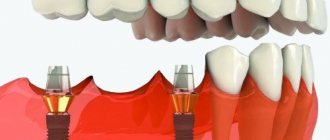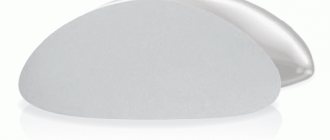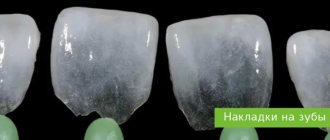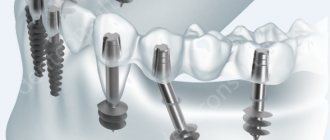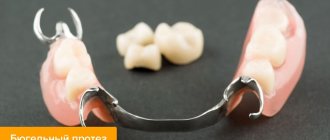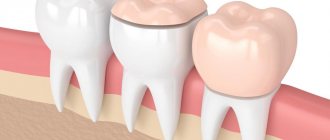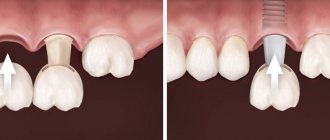Implantation is the installation of artificial teeth to replace lost natural teeth. Titanium roots are implanted into the jawbone and covered with artificial crowns. As a result, the functions of the tooth are completely restored - aesthetic and functional. With the help of implantation, you can restore either one tooth or several. The method is gaining great popularity and is becoming available to all patients.
Indications for implantation
Dental implantation allows you to close the defect, both with a single and complete absence of teeth. Prosthetics on implants helps maintain the integrity of the teeth of the upper and lower jaws that come into contact when closing, without treating them for crowns to install a “bridge.” Implants would be the best option:
- when there is a lack of one or more roots in the central or lateral section;
- with a terminal defect (no molars and premolars);
- with complete absence of teeth;
- if you are allergic to components of prostheses (for example, hypersensitivity to acrylates in removable plate structures precludes their use).
Pros of dental implantation
The loss of even one tooth causes not only aesthetic, but also functional damage. Therefore, restoring the beauty and integrity of the dentition is not the only positive aspect. Advantages of treatment:
- Rational distribution of load in the jaws. The chewing process involves muscles, ligaments, joints, and the remaining antagonists take on the function of the lost root. This leads to overload not only of the bite, but also of the entire maxillofacial area. The integration of the titanium root helps to ensure harmonious and uniform pressure on the entire masticatory apparatus.
- Preservation of bone volume. When treating pulpitis and removing the neurovascular bundle of the tooth, the bone tissue begins to decrease. This occurs due to the reduced load on the jaws. Dental implantation stops jaw atrophic changes.
How are dental implants placed?
Very often people ask what to do if one tooth is lost. Is it possible to restore it using implantation, without grinding down healthy teeth?
First of all, you need to consult with an orthopedic surgeon involved in implantation. After examining the oral cavity, he will tell you how dental implants are placed. It will also be necessary to undergo a preliminary examination with x-rays, a tomograph, and donate blood for tests. After this, the implantation procedure will begin. If insufficient bone tissue volume is detected, it will be increased before installing the implant.
Cons of dental implants
Discomfort in the first days is the main disadvantage of the intervention. In addition, implant engraftment may be accompanied by:
- pain of varying degrees of severity;
- the occurrence of edema and hyperemia; increased body temperature and general malaise;
- the formation of hematomas and bruises on the face.
These negative consequences can change your usual lifestyle, so you should not make serious plans for the next 24 hours. If the surgical field is large, the attending physician may recommend taking sick leave for the postoperative period.
Dental implantation is a very convenient, low-traumatic and effective way to recreate a lost smile, but it is not suitable for all people due to the presence of health problems in which the implant may not take root. To reduce the risk of rejection, we take a responsible approach to the design of medical actions.
Classic implantation
If a patient has indications for classical implantation, then he will have to say goodbye to the idea of quickly restoring teeth in one visit to an implantologist.
Classic implantation consists of two complex stages and requires preliminary bone grafting. You will also have to wait for the implants to heal before installing dentures, which can take many months. Therefore, if there is a need to install implants and prostheses as quickly as possible, then it is better to opt for one-stage implantation with immediate loading.
Types of dental implantation
The surgical technique is chosen depending on the clinical situation in the mouth, the goals of therapy and the anatomical characteristics of the patient. Based on the location of the screw in the jaw, the following types of implantation are distinguished:
Intraosseous or endosseous implantation
The most common today. Endosseous implants have two parts: the root, which is located inside the jaw, and the abutment, which protrudes above the gum. With this type of implantation, the pin is integrated into the jaw. The method is suitable for restoring both single and multiple dental defects, that is, for complete implantation.
Subperiosteal or subperiosteal
The indication for this intervention will be significant atrophy (visible reduction in the height and width of the alveolar process) of the jaws and the impossibility of performing bone grafting. Severe alveolar loss occurs in elderly patients. With the subperiosteal technique, the implant is placed under the periosteum. The design of such implants differs from intraosseous pins. Subperiosteal dentures are thin metal “plates” with supports protruding above the gum. Dental implants completely follow the shape of the jaw and occupy a sufficient area above the preserved alveolar process.
Endosseous (left) and subperiosteal technique (right)
Intramucosal
When a person wears removable dentures and there are pronounced signs of atrophy, the screws are strengthened in the submucosal layer of the gums. The mushroom-shaped shape of the implant holds it well in the mucous membrane and provides sufficient fixation of the orthopedic structure. Mini-implants are used in orthodontic treatment when complex orthodontic movements are required.
Basal implantation
The peculiarity of the manipulation is that the implant is screwed into deeper and harder layers of bone that are not subject to depletion. Unlike the endosal technique, basal dental implantation involves immediate loading. The disadvantage of this method is that it is more traumatic and has a high risk of screw rejection. Currently, the basal technique is used to a limited extent, but in some cases, after trauma or after extensive surgery on the jaws, this method can be successful.
Location of pins for basal and mini-implantation
Dental implantation All-on-4 and All-on-6
The “All on 4” or “All on 6” technique is used for complete edentia. When performing the technology on four implants, dentists restore a smile in 1-5 days. An interesting question: how are implants placed on all teeth using this technique? After all, only 4 supports will be used for 12 crowns. The correct position of the implants allows the pressure to be evenly distributed. Therefore, artificial roots are integrated as follows: two implants are screwed in parallel in the central section and two at an angle of 45 degrees in the lateral areas of the mandibular bone. Since the pins are inclined, this type of intervention can be used without sinus lift (especially when the patient has contraindications to it).
All-on-six technology is almost similar to All-on-four, but due to the increase in the number of supports, it is more reliable and can be recommended for more complex clinical situations: severe defects and deformations of the jaw bones.
Single-stage and two-stage dental implantation
An express method in which a tooth is removed in one visit and an implant is screwed in its place is called one-step or one-stage implantation. This procedure is less traumatic and healing occurs quickly.
Cysts and inflammation in the gums may be a limitation for this method. Then we carry out the operation in two stages. The two-step technique requires a longer visit to the dental office. So, at the first appointment, the doctor removes the damaged root and only after three to six months screws in an artificial pin. During this period, the bone is restored and healed. The long period between tooth extraction and final prosthetics is the main disadvantage of this type of treatment.
Doctor's opinion - The success of the operation is guaranteed in almost 100% of cases
Thanks to the fact that Nobel Biocare has perfected the technology for forming the bioinert coating of its implants, they are not recognized by the body as a foreign body. This means that the success of the operation is guaranteed in almost 100% of cases. In this regard, the list of contraindications for dental implantation is becoming smaller, and the list of indications for surgery is growing.
Levin Dmitry Valerievich
Chief physician, Ph.D.
If one tooth is missing
Possible restoration options are a bridge and implantation.
If the teeth on both sides of the defect are healthy and in ideal condition, then installing an implant with an individual crown will avoid grinding down the adjacent teeth for a bridge.
A cheaper and less traumatic way is to install a dental bridge. The prosthesis is attached to two supporting teeth. But it has disadvantages:
- the need for turning and depulping adjacent, often healthy units;
- decreased functionality and service life of healthy teeth;
- not suitable for end defect repair;
- looks unaesthetic in the smile area.
Lost several teeth in a row
In this case, the defect can be corrected by implantation, installation of a bridge or removable prosthesis.
During implantation, if two teeth in a row are missing, an individual implant is placed in place of each of them, and separate crowns are fixed on top. If 3 or more units are lost, separate artificial roots can be placed for each lost tooth or a smaller number of implants with a bridge fixed on them.
An alternative is to install a dental bridge supported by adjacent living teeth. But as mentioned above, they need to be ground and depulped. If the supports are in poor condition and cannot withstand the load, partial removable dentures are used, which are attached to them with hooks. Both options for traditional prosthetics lead to bone atrophy at the site of the defect.
End defect
Implantation in such a clinical situation is the only possible option. In this case, dentures cannot be installed, since there are no support points for fastening.
Completely edentulous
If the problem is solved by implantation, 4-8 artificial roots are implanted into the jaw, and a removable or permanent fixed prosthesis is placed on top. Fixing the orthopedic structure on the implants allows it to stay firmly in the mouth.
From traditional prosthetics, only a complete removable denture is suitable, which is attached to the gums by suction, but such fastening is extremely unreliable, the denture is unstable, and rubs the mucous membranes.
Inability to wear dentures
Some patients are often allergic to the materials of removable and fixed dentures - acrylic, metal ceramics. In addition, when wearing removable dentures (especially complete dentures on the upper jaw), a gag reflex may occur. Installation of implants solves these problems - the materials of titanium roots are hypoallergenic, crowns on implants do not contain a metal base, we use metal-free orthopedic structures. Removable dentures on artificial roots do not have an artificial palate and do not cause discomfort.
Types of dental implants
The following types of dental implants are successfully used throughout the world:
Titanium implants
Titanium alloy pins are the most common. Their composition is well biocompatible with bone tissue, which affects the effectiveness and favorable prognosis of treatment. The purer the titanium, the better the survival rate of the new root. The exclusion of vanadium and aluminum impurities minimizes the development of allergic reactions.
Implants made of titanium material
Zirconium dental implants
Zirconium dioxide is a strong and reliable metal. The peculiarity of dioxide is the snow-white color of the implant. Such designs will have maximum aesthetics, since the pin will not show through the gum. White metal may be recommended for patients with allergies to titanium-containing mixtures. The main disadvantage is the high cost of zirconium products.
Metal-ceramic dental implants
This kind of root screws does not contain metal. The surface of ceramic screws is porous, which leads to rapid integration of the implant into the bone tissue. Metal-free dental implants can be successfully installed in the anterior region and with a narrow alveolar ridge. This prevents the dark base from showing through through a thin gingival biopsy, and the implant on the front tooth will be invisible. The absence of mucosal pigmentation helps to achieve positive results in prosthetics.
Straumann Pure ceramic system
Let's compare implants from different manufacturers:
| Implant company | Manufacturer country | Price |
| Straumann | Switzerland | From 44000 |
| Osstem | South Korea | From 20000 |
| Hi-tech | Israel | From 26000 |
| Nobel Biocare | Sweden | From 35000 |
| Dentium | South Korea | From 30000 |
| XIVE Ankylos | Germany | From 28,000 rubles |
How to calculate the cost of implantation?
When dental implantation is performed on a turn-key basis, the cost that is initially set may increase due to other additional operations and services. The cost of additional procedures is negotiated separately and is charged on top of the established price. In general, when choosing this method, the patient receives guarantees of high-quality execution of the procedure, since it is much easier for the doctor performing the operation to monitor the patient’s condition.
To calculate the cost of any type of implant installation, you can use a special calculator. Dental implantation is a rather complex procedure, when calculating the cost of which many points must be taken into account - the cost calculated on the calculator is highly accurate, since all these points are taken into account. However, do not forget that the exact price of dental implantation is discussed with a specialist doctor during the initial examination.
How much do dental implants cost?
The question is quite controversial, since there are many manufacturers, as well as promotional offers from various clinics. Price components include the cost of implants, crowns and other materials.
Of course, an implant can be found at a price of about 20,000 rubles per unit, but it is unlikely that anyone will be responsible for the quality. Moreover, it is worth paying more attention to new, unverified manufacturers. On the Russian market, these are representatives of South Korean brands that quite actively import dental implants. The cost of their products can range from 20 to 50 thousand rubles per implant. In addition to these countries, implants are produced by the USA (SuperLine, Bicon) - cost 50 and 75 thousand, respectively, Israel (Alpha Bio, MIS) - cost 25-36 thousand rubles, Switzerland (Strauman, Nobel Biocare) - from 50 to 100 thousand rubles per one implant, France (Anthogyr) – 48 thousand rubles, Germany (Ankylos) – 60 thousand rubles, Sweden (Astra Tech) – 65 thousand rubles.
Which brand to choose is up to you to decide, but it may be a good idea to read reviews from patients on specialized forums who have already undergone this procedure and can share their experience and recommendations on this issue. How much does a dental implant cost? This is a very pressing question for people who have decided to reconstruct their oral cavity by installing new implants. Another question immediately arises - which manufacturer to choose? Firstly, you can pay attention to the products of the Implantium brand, which are used by many dentists. In addition, SuperLine, which uses modern developments in the field of implantation and produces fairly reliable dental implants, also shows good results. Their cost can be 20 - 25 thousand rubles. Another additional positive quality of their products is the general uniformity of the internal diameter of the required holes. The quality of these brands has been tested by practice in Russian markets.
But this concerns the material itself, and how much does it cost to install a dental implant?
The operation itself will most likely cost approximately 35-50 thousand rubles. This includes a full examination of the oral cavity with diagnosis, selection of a suitable model, the operation itself and post-operative care and adjustment if necessary. These activities practically double the total cost, but are absolutely necessary.
How much does a dental implant cost?
Surely this question worries everyone who plans to acquire a “Hollywood” smile in the near future. The quality of the material from which the dental implant is made has a great influence on the price. The cost of many Russian manufacturers may be at the level of 23 thousand rubles. Provided that the installation will be carried out without a crown. This is several thousand cheaper than the average market price of dental implants from European brands and even South Korean companies. However, their main problem may be the inconsistency of their surface treatment with modern quality standards established for this area, plus the services of an orthopedist immediately add to the cost.
As for the prices of crowns, it directly depends on the materials used and is divided into three types: the simplest is metal-ceramics (22 - 29 thousand rubles); the next one is metal ceramics with a gold base, which naturally increases the cost of the design (35 - 47 thousand rubles); and, finally, a crown using a zirconium frame (its cost ranges from 30 to 45 thousand rubles).
Anatomical features of implantation
Depending on which teeth you need to restore - front or chewing, upper or lower - the procedure has its own characteristics.
Mandibular dental implantation
The anatomy of the lower jaw has its own nuances that affect the planning of the operation. Bone has a denser structure, so atrophy processes occur more slowly. This allows you to install implants in the lower jaw without resorting to bone replacement. But, at the same time, the mandibular nerve lies deep in the bone, so a more careful approach and accurate calculation are required.
Implantation of teeth in the upper jaw
The maxillary sinuses are one of the important anatomical cavities of the skull. Often the apexes of the roots communicate with the maxillary sinus, which complicates the implantation of the upper teeth. Even if no communication with the sinus floor was created during apical extraction, the alveolar volume may not be sufficient to secure the implants. In this case, dental surgeons advise doing a sinus lift. This manipulation increases bone thickness by reducing the area of the maxillary sinus. If there are indications for a sinus lift, the duration of prosthetics is increased by an average of six months.
Anatomy of the upper and lower jaw
Front teeth implantation
The central incisors and canines are located in the smile zone, they are visible when speaking and should be not only functional, but also beautiful. The alveolar ridge in the front area is thinner, so the size of the implant should be selected accordingly. If the patient’s financial capabilities allow, then it is better to give preference to zirconium or ceramic screws, abutments and crowns. Careful planning and the use of implant templates will allow the implant to be placed in the most correct position to restore harmonious closure of the dentition.
Implantation of chewing teeth
Molars are the first of the permanent rudiments that appear when the bite changes. They experience the highest load, so they have several roots and a pronounced coronal part. When sixes and sevens are destroyed below the gum level, dentists do not recommend delaying removal and prosthetics. In the absence of inflammatory foci, a one-stage operation is performed; as a result, an implant is installed in the socket of the old root in one visit. Thanks to timely treatment and a one-stage technique, it is possible to avoid bone loss and carry out the procedure without osteoplasty.
Should I get an implant or choose prosthetics?
Implantation does not have the disadvantages of traditional prosthetics - it is the only way to restore dentition for life.
Advantages
- Any number of teeth can be restored
- smile aesthetics, neat appearance
- natural restoration of the jaw bone, no atrophy
- adjacent units are not ground
- no pressure on the gums, no contact with mucous membranes
- even hard food can be chewed without problems
- fast addiction
- no speech impairment
- lifetime service life
- If the prosthesis needs to be replaced, only it is changed. The implants remain in the jawbone and a new orthopedic design is fixed on them
Flaws
- an expensive operation - but if you consider that implants are installed for life, and crowns on them last at least 20 years, the benefits are obvious
- limitations - currently there are fewer and fewer contraindications to implantation, new techniques are being developed, improved artificial roots are being created
- surgical intervention - installing an implant is no more difficult than tooth extraction
- long-term process - with classical implantation, time is required for the implant to heal, during which time the patient wears a temporary butterfly immediate prosthesis, but with an accelerated one-stage technique, under favorable conditions, the crown is fixed immediately after installation of the implant
To summarize: implantation is the most functional and physiological way to restore teeth. If you choose a trusted clinic and a qualified implantologist, installing implants does not carry any risks or complications, and the new tooth will last a lifetime.
Related article:
- Which is better: implantation or prosthetics?
Installation stages and timing of dental implantation
All manipulations are performed in stages.
Preparing for dental implantation
Any surgical treatment begins with preparatory measures. They help determine the patient’s readiness, assess the state of oral health, and detect the presence of somatic abnormalities.
At the first meeting, the implantologist conducts a complete diagnosis of the oral cavity. If there is caries and hard plaque, he refers the subject to therapeutic sanitation. The doctor also necessarily issues a referral for three-dimensional computer diagnostics.
3D CT is an x-ray method for studying enamel, dentin, apexes and bones, which allows you to see the maxillofacial area in a three-dimensional image. From such an image, dental specialists will be able to calculate the length and thickness of the future implant, its position and inclination. Only after tomography analysis is the day of surgery scheduled. If the oral cavity is sanitized and there are no general medical prohibitions, then installation of a dental implant is possible “day-to-day”, immediately after studying CBCT.
Planning and placement of future prostheses on a diagnostic 3D image
An important stage of the consultation is the choice of pain relief. We perform surgical treatment under sedation or local anesthesia only. We recommend using medicated sleep during long-term and large-scale implant procedures.
In most cases, local anesthesia is sufficient for a comfortable and painless procedure. If the patient has concomitant pathology or allergic reactions, our anesthesiologist prescribes additional tests. At the initial appointment, dental implantation methods are determined. The classical technique is most often used, but the dentist can also use modern technologies, for example, a surgical laser. In this case, some dental companies use a beautiful name - “laser dental implantation”.
After a consultation, diagnostic x-rays, a comprehensive examination and a choice of anesthesia, the doctor selects the size of the implants. The next step is implantation of an intraosseous prosthesis.
Installation of a tooth implant and gum former
On the day of the operation, the medical room and the necessary instruments are carefully prepared. The dentist performs local anesthesia and after freezing all his manipulations are completely painless. He then makes an incision in the gum and removes the mucoperiosteal flap, allowing access to the bone. Having exposed the bone tissue, the surgeon creates a hole in it for the pin. The channel is drilled under constant cooling with saline solutions to avoid overheating and improve implant survival.
Depending on the clinical conditions, an FDM or a covering screw is installed, and then the mucosa is sutured. The suture material does not dissolve, so after a week the doctor invites you for a follow-up examination and removal of the fixing threads. It is usually not painful and no anesthesia is required.
The next stage occurs 3-6 months after the new root has engrafted. If the operation is successful, the implant is osseointegrated and the client is ready to attach the abutment and crown.
The formation of the implant bed is carried out with cooling with physiological solutions to avoid bone burns
Dental prosthetics on implants
Restoration of the coronal part can be carried out at different times. Prosthetics with immediate, early and late loading are possible. In immediate restoration, a temporary crown is fixed immediately after surgery. This method is recommended for complete edentia and the “All-on-4” concept. Early loading is carried out within 6-8 weeks, and late loading after 3-6 months. In any case, it will be possible to install a permanent crown once the implant has completely taken root.
What explains the popularity of implants?
Implantation has been known in dentistry for about 50 years, and all this time clinical studies of implants have been conducted, their design has been improved for better osseointegration and minimizing the percentage of rejection. Implantologists' forecast for the future is that in the next 10 years the popularity of the method will increase 3-4 times. There are good reasons for this:
- the quality of implants is improving, they are easy to install;
- complications occur in 2% of cases and are almost always eliminated with timely treatment at the clinic;
- tooth loss is common even in young people, and for such patients comfort and aesthetics are important, which can only be achieved by installing implants;
- the survival rate of artificial roots is close to 100%, the success of implantation is higher than even conventional therapeutic treatment;
- treatment time is reduced due to the development of new technologies;
- information becomes more accessible to patients of all ages.
Recommendations after implantation surgery
After dental implantation, the dentist must give instructions for caring for the postoperative area and for drug therapy. In the early period, doctors often prescribe antibacterial and anti-inflammatory drugs. They will reduce pain and avoid wound infection.
After installing the titanium root, it is necessary to keep the oral cavity clean and use baths with antiseptic solutions. To clean the enamel for the first time, it is better to choose a soft brush. In the first days, physical training, smoking and drinking alcohol should be avoided. Food should be gentle and not hot. Following the recommendations will help avoid complications in the postoperative period.
Answers to popular questions
Is it possible to install implants for diabetes?
Controlled diabetes mellitus is not a contraindication to dental implantation. Based on the results of the analysis for glycated hemoglobin, patients are divided into three groups:
- less than 6% - dental implants can be placed without any restrictions;
- from 6% to 8% - implantation is possible, but with minimal risk (special preparation is required);
- more than 8% - surgery is possible only after the patient reduces the level of glycated hemoglobin to the required levels.
The Family Dentistry clinic successfully performs dental implantation for diabetes mellitus according to an individual treatment plan, taking into account the specific clinical picture. We try to use technologies that allow us to avoid bone grafting - the operation is less invasive (traumatic), and healing is easier. In addition, we install Straumann implants with the hydrophilic surface SLActive, which eliminates blood supply disturbances in diabetes and promotes successful osseointegration in bone tissue.
Is it possible to place implants with periodontitis or periodontal disease?
Yes, you can. But treatment is required first, incl. Possibly gum and bone grafting.
With periodontitis, bone tissue atrophies, so osteoplasty may be required at the time of implantation of a titanium rod into the jawbone. Some clinical situations allow you to install an implant immediately after gum surgery for periodontitis, while others require up to 6 months for the bone material to engraft.
In patients with periodontitis, the gums are less dense and decrease in width and height. This is dangerous because a pocket may form between the neck of the implant and the gum, in which bacteria will accumulate. As a result, there is a high risk of titanium screw failure. That is why the dental surgeon first performs gum surgery.
What anesthesia is used to place dental implants?
Local anesthesia is most often used. It is enough so that the patient does not experience any pain when installing implants. A combination of local anesthesia with sedation (a state of drug-induced semi-sleep) helps to cope with the experience.
It is important to understand that the jawbone is not innervated. Therefore, it is necessary to numb only the mucous membrane, which local anesthesia copes well with.
Why does an implant take root faster when installed in the lower jaw than in the upper jaw?
Yes, titanium rods implanted in the lower jaw take root within 2-4 months, and in the upper jaw - from 3 to 6. This is due to the fact that the mandibular bone tissue is more dense.
What are the dangers of smoking after implantation?
Until about 10 years ago, smoking was an absolute contraindication to the installation of implants, and many dental clinics simply refused such patients who were at risk.
Nowadays, even heavy smokers are implanted, but smoking remains the worst enemy of dental implants. It promotes the growth of bacteria in the mouth and accelerates the formation of plaque. It also leads to irritation of the mucous membrane and constriction of blood vessels, slowing down the healing process of tissues after surgery. Thus, smoking not only significantly slows down the process of engraftment of artificial roots, but also increases the risk of their rejection.
Can I drink alcohol after getting dental implants?
It is advisable to avoid alcoholic beverages not only while taking antibiotics after implantation, but also for the entire period of osseointegration (i.e., 3-6 months) for the following reasons:
- irritates the mucous membrane, slowing down the process of engraftment of the titanium rod;
- dilates blood vessels, causing bleeding at the site of implantation of the artificial root;
- increases the risk of developing hematoma.
Still have questions about installing implants? Get a free consultation with an implantologist.
| Expert, author of the article: Akhtanin Alexander Pavlovich Orthopedic dentist, implantologist 35 years of implantation experience Material updated: October 11, 2021 |
Complications after dental implantation
On the first day, swelling, hematomas and redness may appear in the surgical area. Local reactions can last from three days to two weeks. Late problems include peri-implantitis and implant failure. This occurs due to inflammation of the jaw bone around the post. First, the patient notices redness of the gums around the prosthesis, later mobility of the implant and its loss appear.
But we use modern implant systems and proven medical protocols, which minimizes the risk of unpleasant consequences. And the highly qualified doctors completely exclude the development of serious complications.
Question answer
Basal implantation was recommended. Is this method suitable for everyone?
Basal implantation is a technique practiced by some Moscow clinics. This method is the complete opposite of time-tested classical implantation. Implant installation is carried out without bone tissue augmentation in case of its deficiency. Artificial roots are placed in that part of the jaw where atrophy does not occur - the basal one, often at an angle, which contradicts the natural location of the tooth root (it doesn’t matter - natural or artificial).
Levin Dmitry Valerievich
Maxillofacial surgeon, chief physician of the Center
Contraindications to dental implantation
Dental implantation is a universal method for eliminating defects in the jaw rows, but it is not always possible. Some restrictions make intervention impossible or require additional preparation. In dentistry, there are 2 groups of contraindications - general and local.
Are common
Absolute:
- Diseases of the hematopoietic system;
- Pathology of the central nervous system;
- Oncological processes;
- Rheumatoid connective tissue lesions - systemic lupus erythematosus, scleroderma;
- Tuberculosis infection;
- Immunosuppressive conditions and serious disruptions in the functioning of the immune system;
- Diseases of the endocrine system in decompensated form.
Relative contraindications:
- Pregnancy and lactation;
- Childhood.
Local
Relative:
- Poor oral hygiene;
- A large number of carious cavities, lack of sanitation;
- Periodontal diseases;
- Bite pathologies;
- Alveolar process atrophy;
- Bruxism and pathological abrasion;
- TMJ diseases;
- Bad habits (tobacco smoking, alcohol abuse).
Absolute:
- Sjögren's syndrome;
- Chronic recurrent aphthous stomatitis;
- Pemphigus.
Factors influencing the quality of dental implantation
Implantation is acceptable at any age. Of course, the general physical condition of the person, the presence of various diseases, as well as the need for dental restoration are taken into account. Thanks to the painstaking work and constant research of scientists and implantologists, today unique, universal implants have been created, the implantation of which is due to a minimal risk of rejection.
Dental implantation at YuliSTOM is always a successful procedure because we:
- We give a correct clinical assessment of the condition of the dentition and oral cavity as a whole
- we check the oral cavity for the absence of infections, treat them if necessary before installing implants
- We carefully follow the surgical protocol during the dental implantation process
- We professionally perform the orthopedic stage of dental prosthetics on implants
- we guarantee the quality of the implants used
You can make an appointment and receive an individual consultation with a detailed treatment plan at the YuliSTOM dental clinic (if you live near the metro stations: Zvezdnaya, Moskovskaya, Kupchino, Park Pobedy, Frunzenskaya and other stations in St. Petersburg).
How is dental implantation performed and why is it needed?
This question is quite complicated, let’s first figure out how implantation is generally carried out and why it is needed. Dental implantation is often not a whim, but a vital necessity. The most common reason people get dental implants is appearance. Many of us work in direct contact with people, so it is very important to always look great. And a lost tooth, especially if one of your front teeth was removed, makes your smile not the most beautiful. And here you have to somehow get out of the situation, which is why many decide to have dental implants. Moreover, with the correct selection of implants and their color, few people will be able to understand that the tooth is not actually real.
